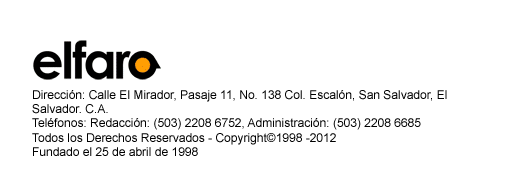HEALTH AND EDUCATION SPENDING UP IN EL SALVADOR'S 2006 BUDGET
Publicado el 8 de Septiembre de 2011
id: 42305
date: 10/7/2005 16:36
refid: 05SANSALVADOR2764
origin: Embassy San Salvador
classification: UNCLASSIFIED
destination: 05SanSalvador1626
header:
This record is a partial extract of the original cable. The full text of the original cable is not available.
----------------- header ends ----------------
UNCLAS SECTION 01 OF 03 SAN SALVADOR 002764
SIPDIS
STATE PASS USAID FOR SBRENT AND USTR FOR FSIDDIQI
STATE ALSO PASS MCC FOR FMCNAUGHT
USDOC FOR 3134/USFCS/OIO/WH/MKESHISHIAN/BARTHUR
USDOC ALSO FOR 4332/ITA/MAC/MSIEGELMAN
TREASURY FOR MFRANCO
E.O. 12958: N/A
TAGS: ECON, EFIN, PGOV, KTDB, ES
SUBJECT: HEALTH AND EDUCATION SPENDING UP IN EL SALVADOR'S
2006 BUDGET
REF: San Salvador 1626
Summary and Introduction
------------------------
1. On September 29, Minister of Finance Guillermo Lopez
Suarez submitted the government's $3.3 billion budget
proposal for 2006, an 11.6 percent increase over the budget
approved for 2005. The Ministry of Education would see
funding increase by 5.6 percent, while the Ministry of
Health would receive an additional 13.6 percent. Other
government institutions working in the area of health and
education would also see budget increases under the
proposal. The budget also includes $14.4 million in funding
for Red Solidaria, the government's anti-poverty program
that focuses on the 32 most impoverished municipalities in
the country. Increased tax revenues and additional bond
offerings will finance the budget increase; the fiscal
deficit is forecast at about 2.7 percent of GDP. We expect
that defections from the communist-led FMLN over the last
year will result in a smoother approval process than in
years past. End summary and introduction.
Spending on Social Issues to Increase
-------------------------------------
2. President Saca's governance plan, "Secure Country," aims
to improve social conditions through the expansion of
education and health services. The 2006 budget, which
President Saca presented to the Legislative Assembly on
September 30, includes modest increases in social spending
supportive of his plan. The government proposes spending
about $1.094 billion on health, education, and related
social programs, up 6.2 percent from the $1.030 billion
budgeted for 2005. Looking at the consolidated government
budget, which includes spending by decentralized government
agencies, the government proposes a $1.585 billion budget,
up 8.9 percent from $1.456 billion in 2005. Commenting on
the budget, Saca said "This budget is focused on social
development, while maintaining a commitment to fiscal and
macroeconomic stability."
Long-Term Commitment to Education
---------------------------------
3. Education reform led by the Ministry of Education during
the last decade has produced significant achievements in the
areas of access to education, curriculum development,
teaching strategies, testing systems, and decentralization.
Nonetheless, challenges persist, particularly in poor, rural
areas, where enrollment and literacy rates remain low. The
government's Plan 2021, a long-term strategy that aims to
achieve Millennium Development Goals for education, focuses
on improving education-completion rates for the whole
population and increasing the competitiveness of the
workforce.
4. Included in Plan 2021 are specific targets for spending
on education for the next 15 years: 3.1 percent of national
income in 2005, 4.2 percent in 2009, and 6.3 percent in
2021. The 2006 budget proposal includes $510.7 million for
the Ministry of Education, a 5.6 percent increase over last
year's $483.4 million. Total spending on education for
2006, including spending by municipalities and independent
government agencies, is not yet available, but is expected
to increase over last year's $519 million.
Healthcare Spending to Increase
-------------------------------
5. Since 2001, the Ministry of Health has decentralized its
operations to provide healthcare through health centers
located near rural and urban population centers. President
Saca's "Secure Country" governance plan recognizes that to
achieve universal healthcare coverage, government spending
must increase. Under the plan, funding for the Ministry of
Health (one of several providers of healthcare to the
public) would increase from a current 1.6 percent to 3.0
percent by 2009. In 2006, the Ministry of Health, which
operates public health centers that offer free preventative
care and vaccines, is budgeted to spend $313.1 million, up
13.6 percent over the $275.5 million budgeted for 2005.
Meanwhile, national hospitals are budgeted to receive $248.7
million in 2006, up 10.4 percent from $225.3 million in
2005.
6. Total government spending on healthcare in 2005 is
estimated at $688 million. That amount includes government
support for Social Security Institute hospitals and health
units, Ministry of Defense public healthcare programs
(including an anti-dengue campaign), and other public health
programs, in addition to the Ministry of Health and national
hospitals' budgets. Detailed budget data is not yet
available to arrive at a similar estimate for 2006, but
given the increase in the Ministry of Health and hospitals'
budget, it is likely that total spending will increase
compared to 2005.
Funding Budgeted for Anti-Poverty Program
-----------------------------------------
7. To bring economic development to poor, rural
communities, the government launched a national poverty
program called Solidarity Network (Red Solidaria) in March
2005 to assist families in 100 municipalities affected by
severe and high extreme poverty (Ref. A). The program,
which will focus initially on the poorest 32 municipalities,
is budgeted for $14.6 million in 2006: $7.4 million will go
toward direct subsidies of $15-20/month for single mothers
who send their children to school, $800,000 will support
local NGOs' health and education programs, and $6.4 million
will go toward infrastructure projects. The Ministries of
Health and Education will support the program by directing
funding from their own budgets to these poorest
municipalities.
Other Budget Initiatives
------------------------
8. President Saca has committed to making social issues the
central focus of his presidency, but the budget also
reflects commitments he has made elsewhere. The budget
proposed includes a 12.7 percent increase in funding for the
Ministry of Economy, to establish a new Consumer Protection
Agency and to support projects in support of CAFTA-DR
implementation. The Labor Ministry would see its budget
increased from $7 to $8.6 million and the underfunded,
fledgling Tourism Ministry from $200,000 to $5.8 million.
Fulfilling a promise made in February 2005, the budget also
includes a pay raise for 76,000 government employees
(excluding independent agencies that have their own pay
scales, as well as medical and teaching staff at the
Ministries of Health and Education), allocated as follows: a
10 percent increase for those who earn less than $400/month,
an 8 percent increase for between $401 and $700; a 6 percent
increase for between $701 and $1,000, and a 3 percent
increase for over $1,000. The president, vice president,
ministers and vice ministers would receive no raise.
9. Although the budget does include an overall spending
increase of $346 million, increasing spending on health and
education--while maintaining the fiscal responsibility
required to keep a good credit rating--has required the
government to propose a number of budget cuts as well.
Overall, capital spending would decrease 4.6 percent, from
$462.3 million in 2005 to $441.2 million in 2006.
10. Several ministries would see their budgets sharply cut;
details are unavailable on what programs in particular will
be affected. The Foreign Ministry would see its budget
slashed by 28.4 percent, falling from $43.6 million in 2005
to $31.2 million in 2006, while the budget for the
Environmental Ministry would be cut from $13.6 million to
$7.7 million. The most difficult tradeoff is the proposed
budget cut for the Ministry of Governance, which is
responsible for public security; that ministry would see its
budget cut from $196 million to $187 million.
11. Two ongoing natural disasters--a volcanic eruption and
extraordinary rains over the past two weeks--are likely to
complicate the government's budget planning. The government
will be forced to deal with a range of social and economic
challenges caused by evacuations and infrastructure damage.
Already, officials have announced that it will cost $178
million to respond to the crisis, but that figure could rise
quickly. Using these funds, and others provided by external
sources in response to the disaster, President Saca has said
his government will focus on disaster mitigation, including
drainage and levee improvements to prevent floods and
mudslides.
Financing the Budget
--------------------
12. The government proposes financing nearly a quarter of
the budget, $846.8 million, through loans ($183.1 million)
and bond sales ($663.7 million). Tax revenues, which have
increased substantially over the last year thanks to
improved tax collection, are expected to contribute $2.362
billion to government coffers, up 10.2 percent over last
year's budgeted $2.048 billion. Other sources of income
(investment returns and assets sales, for example) would
account for another $129 million. Under this scenario--and
with economic growth forecast at 3.5 percent and inflation
at 2.5 percent--the government projects a fiscal deficit of
2.7 percent of GDP and a level of debt of 38.5 percent of
GDP for 2006. This excludes $400 million in anticipated
pensions payments and other smaller financial commitments.
Minister of Finance Guillermo Lopez Suarez, commented in
local newspapers that "The macroeconomic figures are
sustainable, and the deficit is lower compared to 2005,
which was 3.3 percent [of GDP]."
Comment: Swift Budget Approval More Likely
------------------------------------------
13. We expect that budget approval for 2006 (the fiscal
year runs concurrent with the calendar year) will come more
easily this year than last for President Saca and his ARENA
party, thanks to the defection of seven FMLN deputies over
the last year. In fact, it was last year's budget battle
that began the exodus. With only 24 deputies now (down from
31), the FMLN alone cannot muster enough votes to block the
budget, which requires a simple majority, or the
international financing, which requires a two-thirds
majority. ARENA will look to the new Democratic
Revolutionary Front (FDR), and other smaller parties, to put
together the votes needed. We expect deputies from those
parties to be amenable to ARENA efforts to secure their
support, but based on prior experience, that support could
come with a cost to the government in other areas. End
comment.
BUTLER
=======================CABLE ENDS============================




